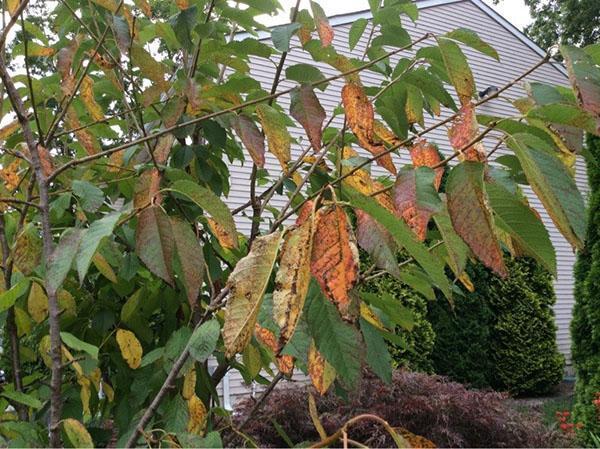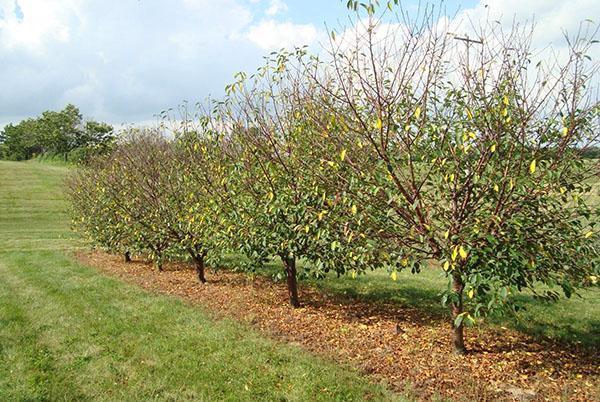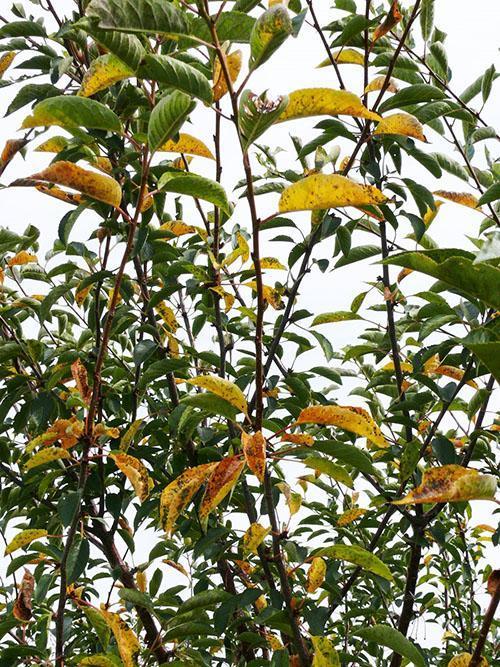Cherry coccomycosis is a threat to your garden
 Cherry coccomycosis is one of the newest and most dangerous diseases of stone fruit crops. The first cases of contamination of gardens in the USSR were identified in Latvia. This happened in 1956. Then, from 1960 to 1962, signs of the disease appeared in neighboring republics: in Ukraine, Belarus and Estonia. A few years later, a previously unknown disease was described by gardeners of the Central Black Earth Region. Here, plantings in the Tambov and Lipetsk regions suffered from cherry coccomycosis.
Cherry coccomycosis is one of the newest and most dangerous diseases of stone fruit crops. The first cases of contamination of gardens in the USSR were identified in Latvia. This happened in 1956. Then, from 1960 to 1962, signs of the disease appeared in neighboring republics: in Ukraine, Belarus and Estonia. A few years later, a previously unknown disease was described by gardeners of the Central Black Earth Region. Here, plantings in the Tambov and Lipetsk regions suffered from cherry coccomycosis.
Cherry coccomycosis: what is it?

The disease affects the foliage of trees, leads to premature leaf fall and seriously weakens fruit-bearing plantings.
Gardeners are well aware of the signs and consequences of coccomycosis infection, but at the same time, scientists have not yet decided what type of fungi causes a serious illness in fruit trees. Today, two harmful microorganisms claim to be the causative agent of cherry coccomycosis:
- Blumeriella jaapii, described and included in the international classification in 1961;
- Coccomyces hiemalis, known since 1847.
Whatever fungus is guilty of the disease, it acts massively and insidiously. In favorable conditions, for example, in a warm, humid summer, coccomycosis can affect large areas. But in the first year, the gardener will not notice the loss of the crop, but will only be surprised that the foliage from the trees will begin to fall off in the middle of summer.
 Trees infected with harmful fungi stand with bare branches in August. This is precisely the picture observed today by most gardeners throughout the central part of Russia. Due to a violation of the biological cycle, cherries with coccomycosis do not have time to prepare for wintering. Frosts cause:
Trees infected with harmful fungi stand with bare branches in August. This is precisely the picture observed today by most gardeners throughout the central part of Russia. Due to a violation of the biological cycle, cherries with coccomycosis do not have time to prepare for wintering. Frosts cause:
- death of young growth;
- cracking of the bark;
- damage to flower and growth buds.
For several years, orchards affected by coccomycosis are significantly thinning and losing their former productivity. Added to this is a decrease in the quality of fruits, which are much worse and slower to pour and accumulate sugar.
By the time of harvesting, the fruits on the branches look more like skin-covered seeds than everyone's favorite cherries.
The old varieties, the most beloved in Russia, were not ready for the action of the causative agent of coccomycosis. For example, cherries Lyubskaya and Vladimirskaya naturally almost disappeared from industrial and amateur plantings. And this circumstance forced the breeders to start breeding new varieties of cherries resistant to coccomycosis. Such work is underway, but scientists cannot yet achieve full immunity. Trees of varieties resist fungi better than others Chocolate girl, Turgenevka, Covesnitsa, Kharitonovskaya, Student some others.
Unfortunately, the late detection of the infection, its accumulation and rapid spread have made fungicides an indispensable tool for the gardener.
The most active spread of fungal spores is:
- at an air temperature of about 19-23 ° C;
- in wet weather, accompanied not only by rain, but also by fog or dew;
- during strong winds, helping spread the infection.
 Chernozem plantations of the north-western region, the Non-Chernozem region, the northern regions of the Chernozem region and neighboring regions are most endangered. Here, treating gardens with fungicides and copper-containing preparations has become a routine annual activity.
Chernozem plantations of the north-western region, the Non-Chernozem region, the northern regions of the Chernozem region and neighboring regions are most endangered. Here, treating gardens with fungicides and copper-containing preparations has become a routine annual activity.
The further south, where the summer is hotter and drier, the less frequent the manifestations of the disease, so spraying with chemicals and other measures to treat cherry coccomycosis is carried out as needed. True, the task is complicated by the fact that the fungus affects not only cherry orchards, but also related crops. Suffers from a dangerous disease:
- apricot;
- cherry plum;
- cherries;
- bird cherry;
- plum.
At the first signs of the disease on related crops, all measures to combat coccomycosis are used and on cherries.
Life cycle of cherry coccomycosis causative agent
Spores of the fungus perfectly tolerate Russian winters, waiting out the cold:
- on the fruits and leaves remaining on the branches;
- in cracks in the bark, especially prone to gum flow;
- on plant debris under a tree;
- on the ground surface.
 With the arrival of heat, spores are thrown into the air and carried by drops of moisture and wind. This usually happens before the buds open, and when they get on young moist foliage, they quickly germinate and penetrate the plant tissues.
With the arrival of heat, spores are thrown into the air and carried by drops of moisture and wind. This usually happens before the buds open, and when they get on young moist foliage, they quickly germinate and penetrate the plant tissues.
The first manifestation of cherry coccomycosis looks like yellowing or reddening of a part of the leaves, unexpected for the beginning of summer. Then, on the surface of the leaf plates, small rounded dots of dark or brown color appear. Over time, the spots become larger, they merge and occupy most of the leaf. Gradually, the fabric of the leaf plate dries up and dyes out.
Turning over the fallen diseased leaf, you can see the whitish or pinkish pads with new ripening spores.
The causative agent of cherry coccomycosis can reproduce up to eight generations per season, therefore, without urgent and decisive measures, the chances of saving the garden are minimal.
Measures to combat cherry coccomycosis and disease prevention
Cherry coccomycosis control measures begin with laying a garden. Today it is extremely important to choose not only fruitful, but also zoned cherry varieties resistant to moniliosis and coccomycosis. Planting them does not guarantee success, but it will allow you to spend less time treating trees with chemicals.
 In relation to coccomycosis, both old, proven copper-containing agents, such as Bordeaux liquid, and modern systemic fungicides are active. Cherry coccomycosis treatment is carried out in several stages:
In relation to coccomycosis, both old, proven copper-containing agents, such as Bordeaux liquid, and modern systemic fungicides are active. Cherry coccomycosis treatment is carried out in several stages:
- in early spring, on still unopened buds at the green cone stage;
- before flowering or in its first days;
- immediately after the petals fall;
- in a month, if the selected drug allows such a procedure;
- before falling leaves.
When the foliage has already fallen, and the gardener is preparing to end the season, it is useful to treat the crown and trunk circle with a 5% urea solution. This will fertilize the plants and destroy pathogens and pests that are prepared for wintering.
Treatment of cherry coccomycosis with folk remedies is not carried out, but preventive measures will be very useful. They will help protect the garden not only from this fungal disease, but from moniliosis, other diseases of fruit crops and their pests:
- Foliage, as it falls, must be collected and burned. Do the same with unharvested fruits remaining on the branches.
- Under the trees during the summer, weeds are regularly pulled out and the soil is loosened.
- For the winter, they dig and cover the trees, protecting them from wind, frost and spring decay.
- In the spring and autumn, sanitary pruning of the garden is carried out, all removed shoots are destroyed.
- Places of cuts, areas affected by lichens or with signs of gum removal are cleaned and processed with garden varnish.
Only adherence to the rules of agricultural technology and constant attention to the state of fruit trees guarantees good yields and longevity of the garden.